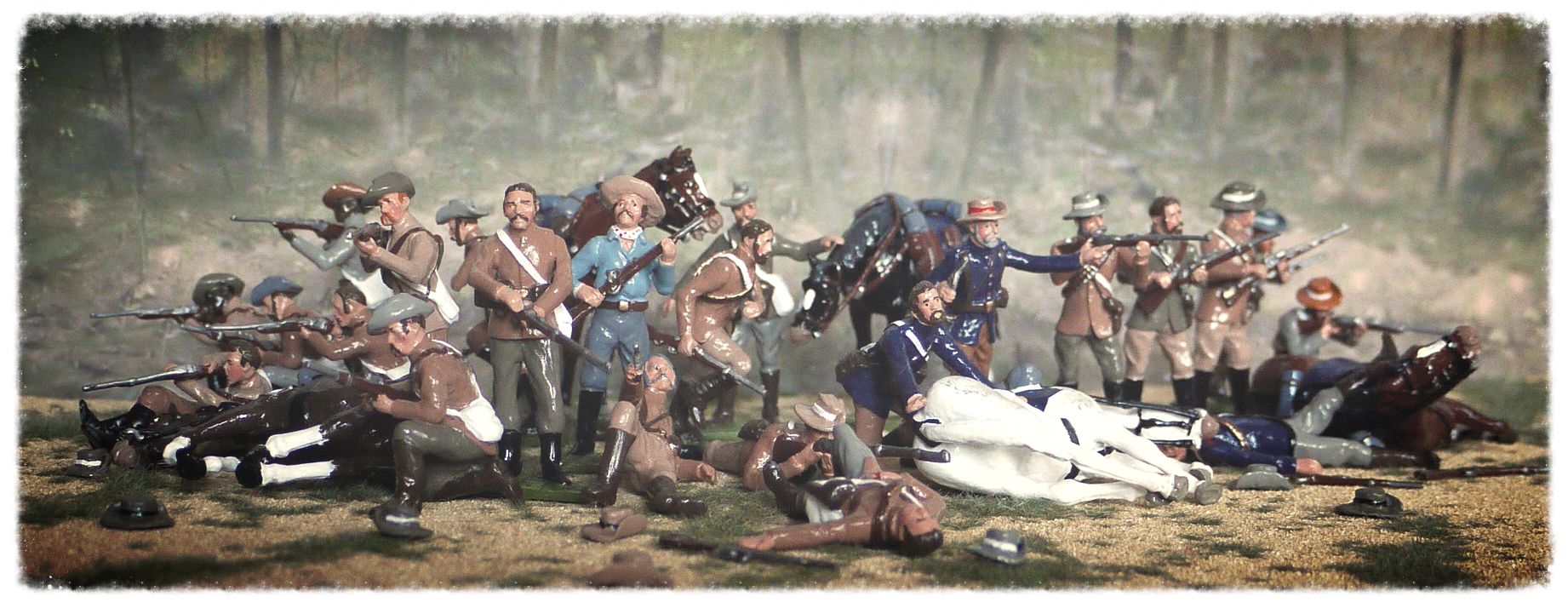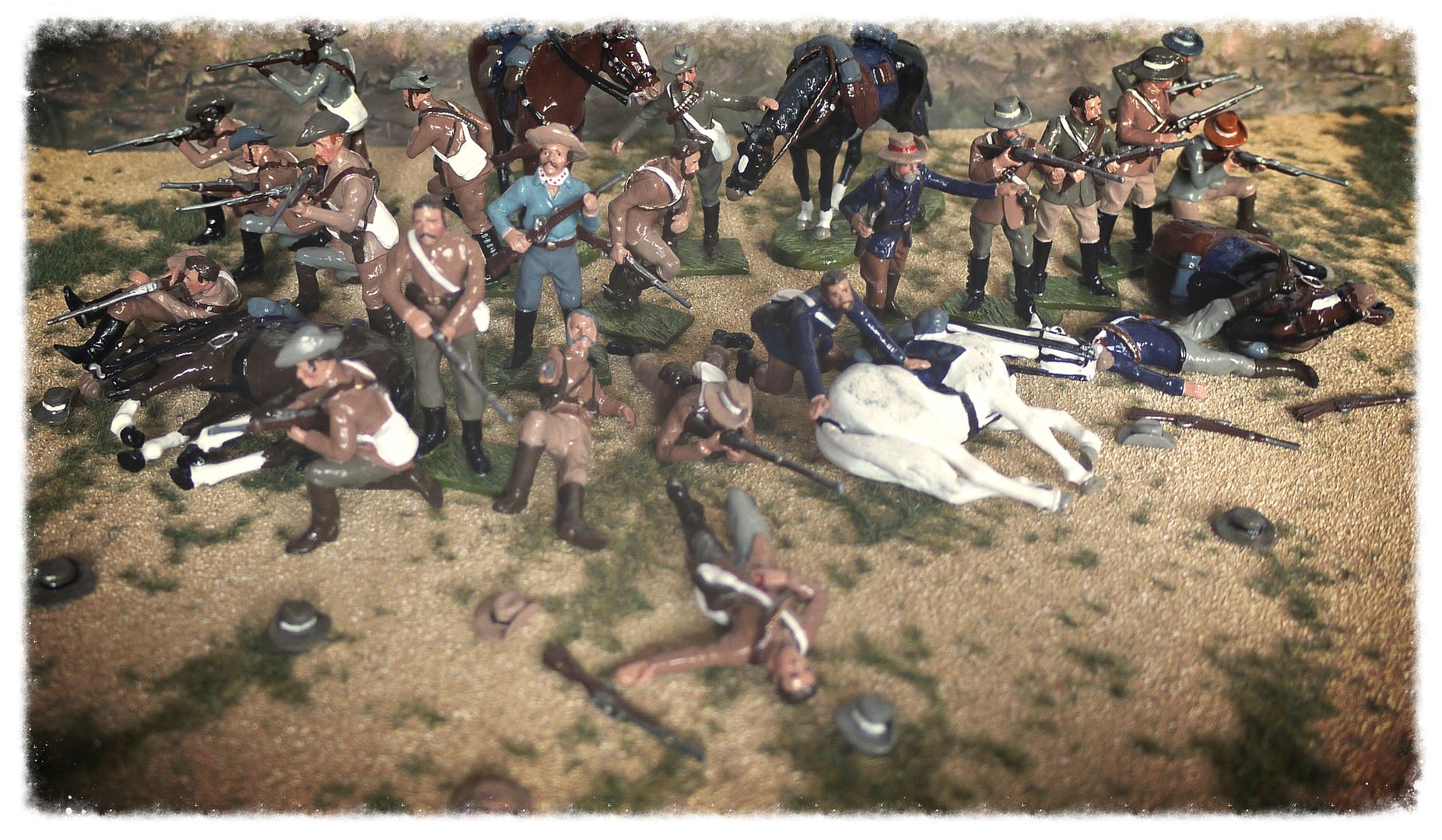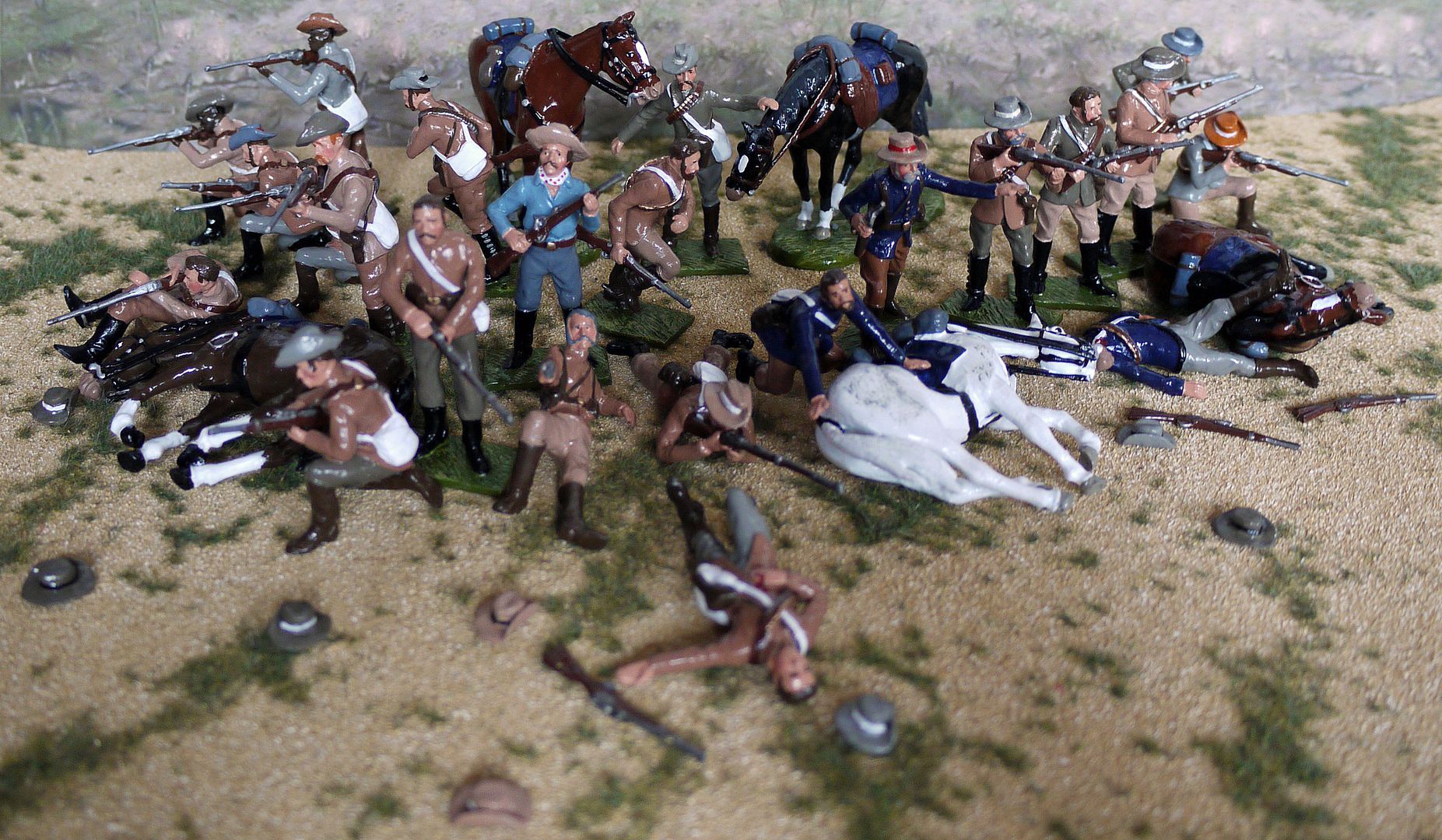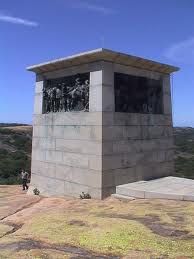GICOP
Four Star General
- Joined
- Oct 16, 2008
- Messages
- 28,015
Last year I asked Mike at LITTLE LEGION if he would take on a "small job" for me :rolleyes2:
I wanted him to recreate, as close as possible, the figures in the famous painting "There were on survivors" by Allan Stewart depicting the Last Stand of the Shangani Patrol. The scene was painted in 1896 therefore the uniform colours should be pretty accurate. To say I am very pleased with the result is a vast understatement ^&grin.
Here is the painting we based the figures on

Here is some info about the action
The Shangani Patrol, comprising 34 soldiers in the service of the British South Africa Company, was ambushed and annihilated by more than 3,000 Matabele warriors during the First Matabele War in 1893. Headed by Major Allan Wilson, the patrol, also referred to as Wilson's Patrol, was attacked just north of the Shangani River in Matabeleland in Rhodesia. Its dramatic last stand, sometimes called Wilson's Last Stand, achieved a prominent place in the British public imagination and, subsequently, in Rhodesian national history, roughly mirroring events such as the Alamo massacre or Custer's Last Stand in the United States.
The subsequent fate of the Wilson patrol, whose bones now rest beneath their memorial on the Matopo hill on which Cecil Rhodes lies buried, was gathered afterwards from Matabele sources. They had selected a clearing among the trees for their last stand and, some standing, some kneeling, poured a hot fire in all directions. The Matabele had the advantage of better cover and took time to aim accurately and make their shots tell. But so calmly and steadily did the patrol fight back that in spite of the bush and the trees they took a heavy toll of the enemy.
At one stage in the fight the Matabele said they had offered the white men their lives provided they laid down their arms and surrendered. Their offer was scornfully rejected. There would be no surrender.
An attempt to break through would mean sacrificing the wounded. That was unthinkable. They would face it together.
The patrol used their dead horses as cover, but their number steadily dwindled. Many were killed outright, and the wounded went on fighting until they lost consciousness. The fight went on until late in the afternoon. Just before the end the few surviving white men staggered to their feet, sang a few bars of "God Save the Queen", shook hands with each other, and waited for the end. It was not long in coming. The Matabele charged them with their assegais, and gave no quarter. One last man escaped for a few precious minutes, gained the top of an anthill a few yards away and shot down several Matabele before a bullet smashed his hip. He was still firing a revolver as the assegais ended his life.
There were no survivors
The men of the patrol came from all corners of the British Empire and beyond, most were born in Britain itself, over a dozen were English Public School and University men, Allan Wilson himself was originally Scottish, while Captain Henry Borrow was born in Cornwall. Also represented in the patrol were South Africa (several members, most prominently Captain William Judd), India (Troopers Dillon and Money), Canada (Scout Robert Bain), and New Zealand (Trooper Frank Vogel).
Here is my attempt to recreate the painting
THE LAST STAND OF THE SHANGANI PATROL






All figures - LITTLE LEGION
Cheers
Martyn
I wanted him to recreate, as close as possible, the figures in the famous painting "There were on survivors" by Allan Stewart depicting the Last Stand of the Shangani Patrol. The scene was painted in 1896 therefore the uniform colours should be pretty accurate. To say I am very pleased with the result is a vast understatement ^&grin.
Here is the painting we based the figures on

Here is some info about the action
The Shangani Patrol, comprising 34 soldiers in the service of the British South Africa Company, was ambushed and annihilated by more than 3,000 Matabele warriors during the First Matabele War in 1893. Headed by Major Allan Wilson, the patrol, also referred to as Wilson's Patrol, was attacked just north of the Shangani River in Matabeleland in Rhodesia. Its dramatic last stand, sometimes called Wilson's Last Stand, achieved a prominent place in the British public imagination and, subsequently, in Rhodesian national history, roughly mirroring events such as the Alamo massacre or Custer's Last Stand in the United States.
The subsequent fate of the Wilson patrol, whose bones now rest beneath their memorial on the Matopo hill on which Cecil Rhodes lies buried, was gathered afterwards from Matabele sources. They had selected a clearing among the trees for their last stand and, some standing, some kneeling, poured a hot fire in all directions. The Matabele had the advantage of better cover and took time to aim accurately and make their shots tell. But so calmly and steadily did the patrol fight back that in spite of the bush and the trees they took a heavy toll of the enemy.
At one stage in the fight the Matabele said they had offered the white men their lives provided they laid down their arms and surrendered. Their offer was scornfully rejected. There would be no surrender.
An attempt to break through would mean sacrificing the wounded. That was unthinkable. They would face it together.
The patrol used their dead horses as cover, but their number steadily dwindled. Many were killed outright, and the wounded went on fighting until they lost consciousness. The fight went on until late in the afternoon. Just before the end the few surviving white men staggered to their feet, sang a few bars of "God Save the Queen", shook hands with each other, and waited for the end. It was not long in coming. The Matabele charged them with their assegais, and gave no quarter. One last man escaped for a few precious minutes, gained the top of an anthill a few yards away and shot down several Matabele before a bullet smashed his hip. He was still firing a revolver as the assegais ended his life.
There were no survivors
The men of the patrol came from all corners of the British Empire and beyond, most were born in Britain itself, over a dozen were English Public School and University men, Allan Wilson himself was originally Scottish, while Captain Henry Borrow was born in Cornwall. Also represented in the patrol were South Africa (several members, most prominently Captain William Judd), India (Troopers Dillon and Money), Canada (Scout Robert Bain), and New Zealand (Trooper Frank Vogel).
Here is my attempt to recreate the painting
THE LAST STAND OF THE SHANGANI PATROL






All figures - LITTLE LEGION
Cheers
Martyn


